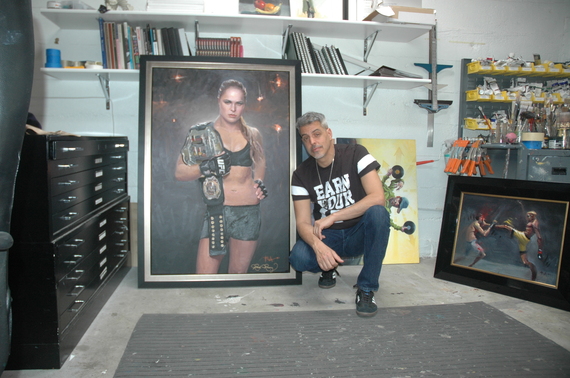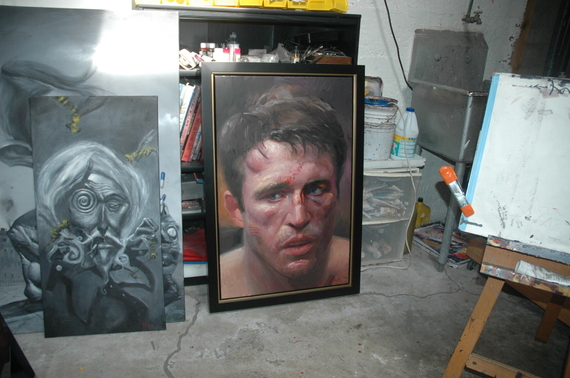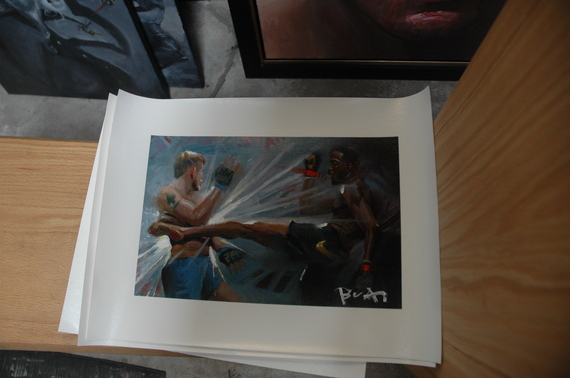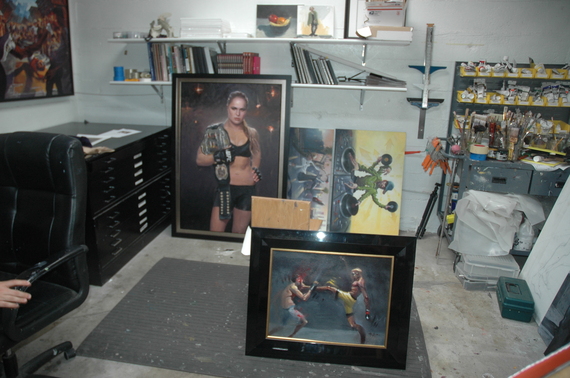Imagining a Venn diagram of combat sports and painting, it's difficult to conceptualize any logical correlation between the two art forms. Martial arts favor heavy, powerful strikes, while visual arts prefer the finesse of light, deft strokes.
But somewhere, in between the brutality of mixed martial arts and the delicacy of painting, acclaimed street artist Justin Bua has found the connection that ties these vastly different worlds together.
"There's an intersection with fighting and painting because it's incredibly a thinking man's sport. It's not necessarily the guy who's strongest, not necessarily the guy who's the most aggressive. It's not the guy who hits the hardest. It's the guy who outthinks the opponent," offers Bua from his Echo Park studio. "In painting, the greater you get, the less moves you make, the less paint strokes you apply. John Singer Sargent is the purest example of that, five paint strokes and it's a gorgeous painting. He's not sitting there noodling, rendering."
Smitten with mixed martial arts prior to the advent of UFC 1, Bua dabbled in backyard Jiu Jitsu shenanigans in his 20s before temporarily hanging up his Gi to preserve his body for a career in dance and painting. But his love for combat never dwindled, allowing Bua to transform his passion for BJJ, chokes, and joint manipulation into a series of MMA-inspired paintings, featuring some of the UFC's biggest stars.
Beginning with "The Kick," which depicts Anderson Silva's legendary knockout of Vitor Belfort at UFC 126, Bua created his "Art of Fighting" collection. He also contributed pieces to adorn the walls of The Ultimate Fighter house during its 20th season (as well as the upcoming TUF: Brazil 4), and it was during the process of painting mixed martial artists in action that he began to take note of the overlap between the two spheres.
"In Jiu Jitsu, if I go from A to B to C, you know I'm gonna get you in a triangle. If I go from D to E to F, I've got you in an armbar or I can get a kimura... there's all these different ways... I can take advantage of it," explains Bua. "It's very similar to the cerebral process of an artist. It's really being as simple and as clean as possible. Your brushes have to be clean, your paint mixing has to be clean, your strokes have to be bold but powerful and with intention, and that's the same thing with Jiu Jitsu."
Bua, who has since returned to the BJJ mats as spiritual practice and currently hosts Street Art Throwdown on the Oxygen Network, is best known for his street art and hip-hop inspired paintings like "The DJ" and "Piano Man II," gaining acclaim for his "distorted lens," as he puts it. "Kind of fish eye, aerial... dynamic perspective compositions [that] are Renaissance infused, classical paintings with graffiti-esque characters," he adds.
Labeling his style "Bua-ism," the artist has witnessed his paintings of Ronda Rousey, Chael Sonnen and Jon Jones being sold around the globe. And while he's already dedicated many canvases to some of MMA's elite, Bua is still interested in adding to his on-going collection.
"I'd love to paint Nick or Nate [Diaz]," comments Bua. "I think the best face and body in MMA -- it's a weird thing, but as an artist I can say this, like Michelangelo will look at David -- I think the ultimate body and face is Jacare [Ronaldo Souza]. That guy's face is unreal ... you feel like the history of his skull and his shape goes way back into some warrior past. And his body is just bananas."
Outside of his affinity for Jacare and Nick Diaz, who he claims as his favorite fighter, Bua finds additional artistic parallels between MMA and art, comparing UFC great Anderson Silva and Dutch 17th-century portrait artist Rembrandt Van Rijn.
"You know my favorite painters have always been painters like Rembrandt, who you can see the struggle in their work, not artists that have such an easy time dealing with paint. I like to see the struggle," states Bua. "Anderson, he's gone through so much trials and tribulations. He's been to the brink of failure, [against] Chael Sonnen, case and point. He was losing that fight essentially before that. You have to have a lot of adversity."
Silva is a frequent focal point for Bua. Not only was "The Kick" the artist's foray into painting MMA scenes, but Bua also sees Silva as the commensurate equalizer between the art world and mixed martial arts.
Joking that he would like to be able to consider Silva the Bua of MMA, the artist explains that Silva "figured out the matrix of the body and how to move within space. And that's what Jiu Jitsu and painting is. One you're using your whole body, and one you're using your hands and a paintbrush."
He goes on to add that the similarities in movement are "almost like this calculated, perfunctory mechanism where you can feel the digitization of organic rhythm, like fractal geometry, where you can see it unfolding."
Bua's words may sound a bit hokey, but he's a bit obsessed with this matrix of movement, even likening the body control of MMA fighters Silva, Anthony Pettis, and Conor McGregor to that of renowned French dance duo Les Twins.
The comparison between MMA and dance have also manifested in Bua's visual work, as he employs similar techniques and perspectives to his paintings of dancers when etching fight scenes.
"It's much more active. I think that fighting you have to capture the energy and the intensity," offers Bua. "They're a little bit more similar to my dance paintings; you really want to be able to capture that moment in time... I think it's important to capture the spirit of gesture."
And, in closing, Bua offers one final parallel between the martial and visual art worlds.
"Most painters are on drugs. Most painters cheat and use Photoshop. Most painters use a lot of trickery," exclaims Bua, later clarifying that "I think that most painters, whether they're doing drugs or whether they're using Photoshop, or whether they're using photo-heavy reference are cheating in my opinion. That's like the steroids of our generation."




